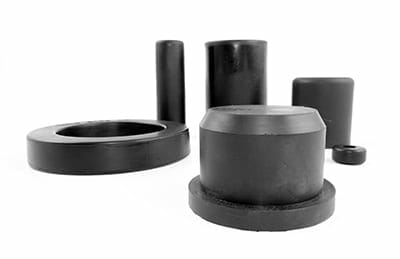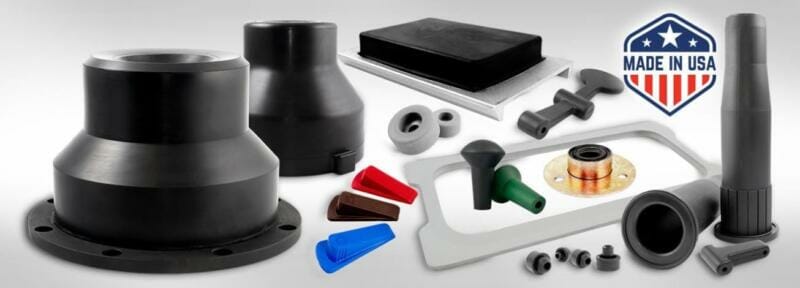Butyl Rubber Products
Physical & Mechanical Properties / Chemical Resistance / Thermal Properties / Environmental Performance / Butyl Applications
What is Butyl Rubber?
Butyl rubber, also known as isobutylene-isoprene rubber (IIR), is a highly adaptable synthetic rubber composed of approximately 98% isobutylene and 2% isoprene. Renowned for its outstanding shock absorption and minimal gas and moisture permeability, it excels in demanding applications. With exceptional resistance to heat, weathering, ozone, abrasion, tearing, and chemical exposure, butyl rubber is well-suited for harsh environments. Furthermore, its broad temperature range enhances its versatility, ensuring consistent performance even in extreme conditions.
The impermeability of butyl rubber to air makes it ideal for applications requiring an airtight seal. Its strength, flexibility, and low gas permeability make it suitable for high-pressure or vacuum-sealed applications. The earliest and most widespread use of butyl rubber was in tire inner tubes, a role it continues to fulfill today.
While butyl rubber is highly versatile, it is not recommended for applications involving contact with petroleum oils. Read on for more information about the properties and advantages of butyl rubber:

Properties of Butyl Rubber
- Isobutylene-isoprene rubber (IIR)
- ASTM D-2000 Classification AA, BA, CA (Standard Classification System for Rubber Products in Automotive Applications)
- Chemical Definition Isobutylene Isoprene Rubber
Butyl Rubber Processing
- Transfer Molding
- Injection Molding
- Compression Molding
Chemical Resistance
- Dilute Acids: Good – Excellent
- Concentrated Fair: – Excellent
- Organic Acids (Dilute): Good
- Organic Acids (Concentrated): Fair to Good
- Inorganic Acids: Good
- Alcohols: Good – Excellent
- Aldehydes: Good
- Dilute Alkalies: Good – Excellent
- Concentrated Alkalies: Good – Excellent
- Amines: Good
- Animal & Vegetable Oils: Good – Excellent
- Brake Fluids, Non-Petroleum Based: Good
- Diester Oils: Poor – Good
- Alkyl Phosphate Esters: Good – Excellent
- Aryl Phosphate Esters: Excellent
- Ethers: Poor – Fair
- Aliphatic Hydrocarbon Fuel: Poor
- Aromatic Hydrocarbon Fuel: Poor
- Extended Fuel (Oxygenated): Poor
- Halogenated Solvents: Poor
- Hydrocarbon, Halogenated: Poor
- Ketones: Poor – Excellent
- Lacquer Solvents: Fair – Good
- LP Gases & Fuel Oils: Poor
- Mineral Oils: Poor
- Oil Resistance: Poor
- Aromatic Petroleum: Poor
- Non-Aromatic Petroleum: Poor
- Ammonia Refrigerant: Good
- Refrigerant Halofluorocarbons: R-12, R-13
- Refrigerant Halofluorocarbons with Oil: Poor
- Silicone Oil: Poor
- Solvent Resistance: Poor

Physical & Mechanical Properties
- Durometer or Hardness Range: 40 – 90 Shore A
- Tensile Strength Range: 500 – 3,000 PSI
- Elongation (Range %): 300% – 850%
- Abrasion Resistance: Fair to Good
- Adhesion to Metal: Good
- Adhesion to Rigid Materials: Fair – Good
- Compression Set: Fair – Good
- Flex Cracking Resistance: Good – Excellent
- Impact Resistance: Good
- Resilience & Rebound: Fair – Good
- Tear Resistance: Good
- Vibration Dampening: Excellent
Thermal Properties
- Low Temperature Range: 70ºF to – 40ºF
- Minimum for Continuous Use (Static): 60ºF
- Brittle Point: 90º F to – 50° F
- High Temperature Range: +250º F to +300ºF
- Maximum for Continuous Use (Static): +300ºF
Environmental Performance
- Colorability: Good
- Flame Resistance: Poor
- Gas Permeability: Good
- Odor: Good
- Ozone Resistance: Excellent
- Oxidation Resistance: Excellent
- Radiation Resistance: Poor – Good
- Steam Resistance: Good – Excellent
- Sunlight Resistance: Excellent
- Taste Retention: Fair – Good
- Weather Resistance: Excellent
- Water Resistance: Good – Excellent
Applications of Butyl Rubber
- Shock mounts
- Sealant for rubber roof repair
- Tubeless tire liners
- Inner tubes
- Stoppers for glass bottles, medicine bottles, and pharmaceuticals
- Used in sealants and adhesives
- Tank Liners
- Sealants, hoses, and mechanical goods
- Adhesives
- Agricultural chemicals
- O-rings
- Electrical fluids
- Personal care products
- Pigment concentrates
- Rubber & Polymer modification

*The usual working temperature range of butyl products is -50°C (-25°C) to +120°C.
Custom Butyl Rubber Products Manufacturer
Qualiform is an ISO-certified, full-service manufacturer specializing in butyl rubber products. We provide custom rubber molding solutions, including rubber compression molding, transfer molding, and rubber injection molding, as well as rubber to metal bonding. From OEM replacement parts to recycling stars with custom finger lengths and configurations, our technical team collaborates with you to ensure optimal design and performance.
With over 50 years of experience, Qualiform is a trusted source for precision-molded rubber components. Contact our experts at (330) 336-6777 to get started on your custom project.
Qualiform Proprietary Blend
Qualiform also offers a proprietary butyl blend with reinforcing fibers. This blend increases wear resistance, durometer, abrasion resistance, toughness and performance properties by implementing reinforcing fibers into the materials. We offer our proprietary blend for all our available rubber materials:
- EPDM Rubber
- Natural Rubber
- Neoprene Rubber
- Nitrile Rubber
- Rigid & Flexible Rubber
- Synthetic Rubber
- Thermoplastic Elastomers (TPE)
- Viton Rubber

